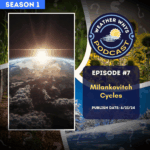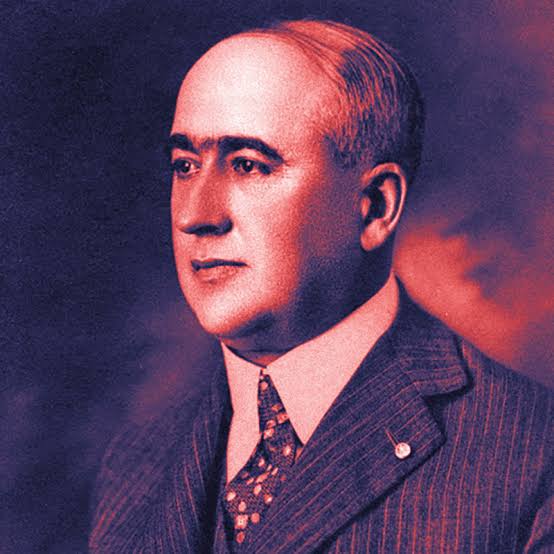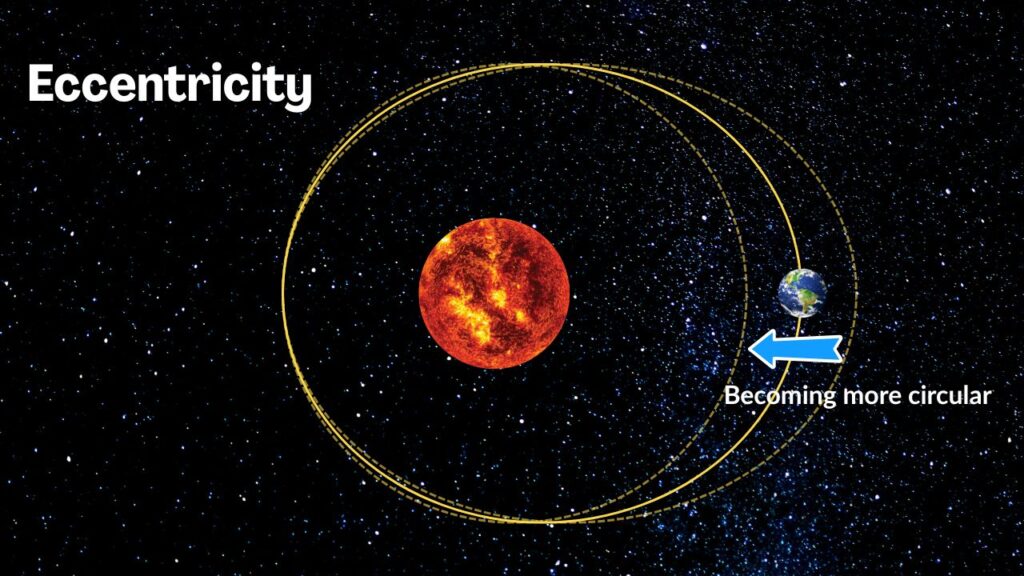
/
RSS Feed
In this episode of the Weather Whys Podcast, host Ed Oswald delves into Milankovitch cycles—changes in Earth’s orbit and rotation that drive long-term climate change. Learn about the Earth’s axial progression, obliquity, and eccentricity, and discover how these cycles impact seasonal contrasts, global warming, and historical climate events.

Explore the intriguing hypothesis linking these cycles to human evolution and understand why they are not responsible for climate change. Tune in to grasp how these changes in Earth’s orbit have shaped our planet for thousands of years.
[00:00:00] While it might not play a role in our day-to-day weather, changes in the Earth’s rotation and orbit around the sun affect our long-term climate. Did you know that the Sahara desert was once a rainforest? Or that Greenland was once regularly ice-free?
[00:00:13] This is the weather-wise podcast. I’m your host ed Oswald. And in this episode, we’re going to explain how that was, and why that will be possible again in the far distant future. Stay tuned. We have a great episode ahead.
[00:00:25] We take the seasons for granted. Winter becomes spring, spring turns to summer, and summer leads to fall. These changes are a result of the Earth’s orbit around the sun, which happens every 365 days.
[00:00:42] But what if I told you the Earth’s orbit isn’t constant? It’s true. Over long timescales, our planet’s orbit and tilt changes. It’s way too small to detect it in a human lifetime, but on geologic timescales, there’s a pattern.
[00:00:55] These patterns are called the Milankovitch cycle Named after Serbian scientist Milutin Milankovitch. He was the first to theorize that the Earth’s orbit on its axis and around the sun changes over time.
[00:01:07] Milankovitch’s findings suggested earth’s orbit changes in one to three ways with progressively longer timescales, wobble, tilt, and orbital shape, or in scientific terms, axial progression, obliquity, and eccentricity.
[00:01:22] The shortest of these it’s axial progression, or our planet’s wobble. Let’s use a spinning top to illustrate this. As it spins, the top wobbles in a circular pattern. Planets do the same thing, just much slower. Our planet takes 26,000 years to complete a rotation.
[00:01:38] The next cycle is obliquity or the amount of tilt that the earth rotates on its axis. over 41,000 years, this tilt varies between 22.1 and 24.5 degrees. This changes the amount of sunlight that the Earth’s surface sees.
[00:01:54] Using the spinning top analogy again, it’s like somebody spun it at an angle. But we’ll have to ditch this analogy for the longest and final cycle, eccentricity.
[00:02:02] Eccentricity is how circular an orbit is, with zero being a perfect circle. Our orbit varies from almost circular to slightly more oval shaped and then back to circular again for a hundred thousand year periods.
[00:02:15] Now that we’ve explained these cycles, let’s put these together in climate terms.
[00:02:19] Planetary wobble affects how extreme the contrast between seasons are. right now, seasons are more extreme in the Southern hemisphere. around 13,000 years from now, the opposite occurs, and seasons become more extreme in the Northern hemisphere.
[00:02:33] The Earth’s tilt may help moderate that, though. When tilt is larger, more sunlight in summer reaches the surface when it’s tilted towards the sun, and less in winter. Right now, the Earth’s tilt is roughly at average science believe the Earth’s tilt is decreasing, however, which will make seasons milder over the next 10,000 years.
[00:02:51] Orbital shape also plays a role in seasonal extremes. Within nearly circular orbit, seasons are generally mild. However, in about a hundred thousand years, the Earth’s orbit will be considerably more elliptical. As a result, the earth receives 23% more sunlight at its closest approach, causing extreme changes between seasons.
[00:03:11] One thing is certain, however: Milankovitch cycles are not the cause of current climate change. Its cycles are too long to explain current changes. However it is a driver of natural change, and one of the reasons why some parts of earth planet change from less rainforests to deserts and a matter of few thousand years, this happens in the Sahara desert. The Earth’s ice ages and their cyclical nature are also thought to be caused by changes in the Earth’s orbit as well. There’s even research supporting the hypothesis that a Milankovitch cycles may have helped human evolution, too.
[00:03:42] However, these cycles are most notable in long-term natural climate change. They seem to explain some, but not all, of these cycles. So, where is the earth headed climatologically over the next one, 10, a hundred thousand years? Scientists have several theories. In general, seasons will moderate overall in the short term, and the planet will continue to warm.
[00:04:04] But this happens on such a long timescale, perhaps tens of thousands of years, that our ecosystem will slowly adapt. That isn’t what’s happening now, where climate change happens in a matter of decades.
[00:04:15] As we move further into the future, the Earth’s tilt will lessen, bringing more sunlight to the poles. The rainforest will move northward as well, bringing deserts to life.
[00:04:25] But at some point tens of thousands of years from now, these trends will be overpowered by a much more elliptical orbit, which may trigger the dawn of a new ice age.
[00:04:33] Luckily humankind has a long time before that becomes possible..
[00:04:37] The Milankovitch Cycles are only a part of our complex climate system. However, understanding how Earth’s rotation and orbit changes with time Allows scientists to better understand our planet’s cyclical climate patterns.
[00:04:50] This was a pretty detail heavy episode, so we have plenty of links in our show notes for you to read further on today’s topic. We’ll certainly return to the subject of climate cycles again in the future, but that’s all the time we have for this episode. We hope you learned something today.
[00:05:05] Weather Whys is a production of The Weather Station Experts and the Weather Whys company. Today’s episode was produced by Derek Oswald and myself from our studios here in West Lawn Pennsylvania. If you’d like to learn more about Weather Whys, visit our website at weatherwhys that’s w H Y s.show. We’d also love to hear from you. You can email us at podcast@theweatherstationexperts.com.
[00:05:27]
[00:05:27] On our website, you can listen this episode or any past episode. Don’t forget to subscribe to weather-wise wherever you listen to podcasts, you can find those links to apple podcasts, Spotify, iHeartRadio, and more on our homepage. That’s all for today. And as always, stay weather-wise.
[00:00:13] This is the weather-wise podcast. I’m your host ed Oswald. And in this episode, we’re going to explain how that was, and why that will be possible again in the far distant future. Stay tuned. We have a great episode ahead.
[00:00:25] We take the seasons for granted. Winter becomes spring, spring turns to summer, and summer leads to fall. These changes are a result of the Earth’s orbit around the sun, which happens every 365 days.
[00:00:42] But what if I told you the Earth’s orbit isn’t constant? It’s true. Over long timescales, our planet’s orbit and tilt changes. It’s way too small to detect it in a human lifetime, but on geologic timescales, there’s a pattern.
[00:00:55] These patterns are called the Milankovitch cycle Named after Serbian scientist Milutin Milankovitch. He was the first to theorize that the Earth’s orbit on its axis and around the sun changes over time.
[00:01:07] Milankovitch’s findings suggested earth’s orbit changes in one to three ways with progressively longer timescales, wobble, tilt, and orbital shape, or in scientific terms, axial progression, obliquity, and eccentricity.
[00:01:22] The shortest of these it’s axial progression, or our planet’s wobble. Let’s use a spinning top to illustrate this. As it spins, the top wobbles in a circular pattern. Planets do the same thing, just much slower. Our planet takes 26,000 years to complete a rotation.
[00:01:38] The next cycle is obliquity or the amount of tilt that the earth rotates on its axis. over 41,000 years, this tilt varies between 22.1 and 24.5 degrees. This changes the amount of sunlight that the Earth’s surface sees.
[00:01:54] Using the spinning top analogy again, it’s like somebody spun it at an angle. But we’ll have to ditch this analogy for the longest and final cycle, eccentricity.
[00:02:02] Eccentricity is how circular an orbit is, with zero being a perfect circle. Our orbit varies from almost circular to slightly more oval shaped and then back to circular again for a hundred thousand year periods.
[00:02:15] Now that we’ve explained these cycles, let’s put these together in climate terms.
[00:02:19] Planetary wobble affects how extreme the contrast between seasons are. right now, seasons are more extreme in the Southern hemisphere. around 13,000 years from now, the opposite occurs, and seasons become more extreme in the Northern hemisphere.
[00:02:33] The Earth’s tilt may help moderate that, though. When tilt is larger, more sunlight in summer reaches the surface when it’s tilted towards the sun, and less in winter. Right now, the Earth’s tilt is roughly at average science believe the Earth’s tilt is decreasing, however, which will make seasons milder over the next 10,000 years.
[00:02:51] Orbital shape also plays a role in seasonal extremes. Within nearly circular orbit, seasons are generally mild. However, in about a hundred thousand years, the Earth’s orbit will be considerably more elliptical. As a result, the earth receives 23% more sunlight at its closest approach, causing extreme changes between seasons.
[00:03:11] One thing is certain, however: Milankovitch cycles are not the cause of current climate change. Its cycles are too long to explain current changes. However it is a driver of natural change, and one of the reasons why some parts of earth planet change from less rainforests to deserts and a matter of few thousand years, this happens in the Sahara desert. The Earth’s ice ages and their cyclical nature are also thought to be caused by changes in the Earth’s orbit as well. There’s even research supporting the hypothesis that a Milankovitch cycles may have helped human evolution, too.
[00:03:42] However, these cycles are most notable in long-term natural climate change. They seem to explain some, but not all, of these cycles. So, where is the earth headed climatologically over the next one, 10, a hundred thousand years? Scientists have several theories. In general, seasons will moderate overall in the short term, and the planet will continue to warm.
[00:04:04] But this happens on such a long timescale, perhaps tens of thousands of years, that our ecosystem will slowly adapt. That isn’t what’s happening now, where climate change happens in a matter of decades.
[00:04:15] As we move further into the future, the Earth’s tilt will lessen, bringing more sunlight to the poles. The rainforest will move northward as well, bringing deserts to life.
[00:04:25] But at some point tens of thousands of years from now, these trends will be overpowered by a much more elliptical orbit, which may trigger the dawn of a new ice age.
[00:04:33] Luckily humankind has a long time before that becomes possible..
[00:04:37] The Milankovitch Cycles are only a part of our complex climate system. However, understanding how Earth’s rotation and orbit changes with time Allows scientists to better understand our planet’s cyclical climate patterns.
[00:04:50] This was a pretty detail heavy episode, so we have plenty of links in our show notes for you to read further on today’s topic. We’ll certainly return to the subject of climate cycles again in the future, but that’s all the time we have for this episode. We hope you learned something today.
[00:05:05] Weather Whys is a production of The Weather Station Experts and the Weather Whys company. Today’s episode was produced by Derek Oswald and myself from our studios here in West Lawn Pennsylvania. If you’d like to learn more about Weather Whys, visit our website at weatherwhys that’s w H Y s.show. We’d also love to hear from you. You can email us at podcast@theweatherstationexperts.com.
[00:05:27]
[00:05:27] On our website, you can listen this episode or any past episode. Don’t forget to subscribe to weather-wise wherever you listen to podcasts, you can find those links to apple podcasts, Spotify, iHeartRadio, and more on our homepage. That’s all for today. And as always, stay weather-wise.
We have a video on this one on YouTube:
Key Points
- 00:00 Introduction to Earth’s Climate Changes
- 00:55 The Milankovitch Cycles Explained
- 02:15 Impact of Milankovitch Cycles on Climate
- 03:51 Future Climate Predictions
- 04:38 Conclusion and Further Reading
Show Notes
- Note: we mispronounced one! It’s axial precession! Was caught too late in post. 🙁
- Changes in Earth’s orbit happen over thousands, if not tens of thousands of years.
- By the way, the correct spelling of the name is Milutin Milanković, but is commonly Westernized when discussing his work.
- From the American Museum of Natural History: Milutin Milankovitch: Seeking the Cause of the Ice Ages


